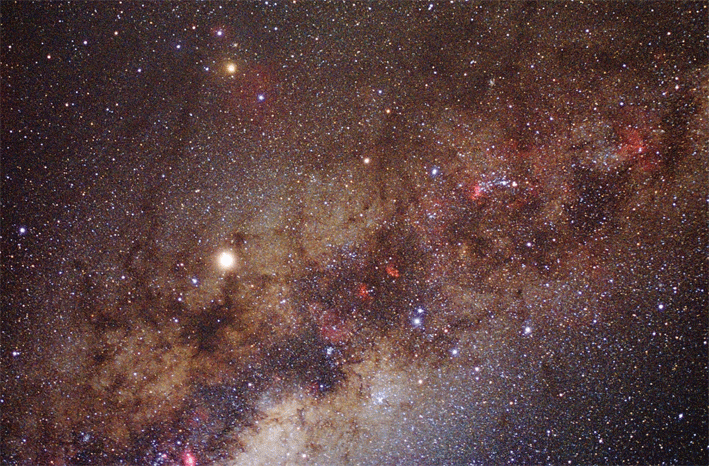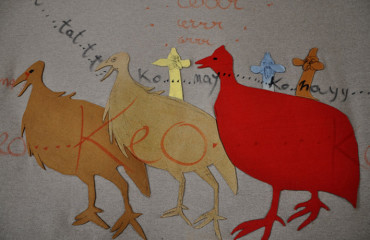
THE PLANETS
MERCURY: for the entire month it is observable at sunset, it will show itself in the best conditions from June 10, the date whereby the planet sets at 1h and 10 m after the Sun. In just 30 days the planet transits in three constellations: at the beginning of the month it is amongst the stars of Taurus, on day 7 it enters Gemini, on day 24 we will find it in Cancer.
VENUS: it is virtually undetectable, immersed in the light of the sunset. In the early hours of June 6th it is in conjunction with the Sun, and is responsible for a rare transit on the disk of our star, even if the event will not be spectacular as it was in 2004, but since the next transit will occur between 100 years I think it is a must to attend this extraordinary event some type of instrument in order to capture the shadow coming out of the planet from the Solar disk.
MARS: is visible in the first part of the night, at the beginning of the month we will find it in the constellation of Leo but on the 21st moves into the constellation of Virgo.
JUPITER: it is hardly detectable at sunrise in the constellation of Taurus.
SATURN: can be seen for most of the night in the constellation of Virgo, a few degrees north of Spica. Also for this month it is the planet that is proper to test our equipment in an attempt to regain some WOS (elusive atmospheric formations more or less circular in shape) and the most common atmospheric bands in addition to the beautiful rings.
URANUS: is visible in the second part of the night in the constellation of the Cetus.
NEPTUNE: visible for almost the entire night and can be found in the constellation of Aquarius.
A DOUBLE STAR EACH MONTH
In this month of June our attention focuses on a purely summer constellation, Hercules , a great constellation, which occupies a large portion of the sky, 1225 square degrees, but not having stars of significant magnitude it isn’t flashy. We decide to point your telescope toward an easily recognisable star – even if not very bright – for its reddish colour, Alpha Herculis; this is our star of the month, a mag3-3.7 with a period of approximately 100 days, and at a distance of 4.7 “, it has a companion star which shines a white light, but by contrast on the telescope it appears green.
Alpha Herculis bears the Arabic name of Ras Algethi, which means “head of the kneeling one”, the vision of the binary system through my little 78 mm fluoride refractor is an unforgettable sight, the chromatic contrast of the magnificent orange colour that shines the alpha and the emerald green of the faint companion remains imprinted on the retina of the eye. Ras Algethi is an orange star, therefore cold, it has a surface temperature of just 2-3 thousand degrees, its diameter is 420 times that of our Sun and shines at a distance from us at 430 a.l., its brightness is 800 times that of the Sun but it is not constant since it is classified as a “semi-regular variable. Thanks to the Ras Algethi system, through spectroscopic measurements, in the last century it was possible to prove that Red supergiants (Betelgeuse and Antares) constantly lose part of their matter in space.
THE OBJECT OF THE MONTH
The open M11 mass is visible through the stellar cloud of the Shield. The celestial region where this beautiful cluster lies is located at almost 3° from the Galactic Equator; in it there are two categories of objects: planetary nebulae and dark nebulae. In an area of 9° squared centred on M11 there are 9 “sacks of coal” classified by the astronomer, Barnard and other planetaries.
Considerable interest is also the variable R Sct, 1° Northwest of M11, of semi-regular type. With a time that seems to be almost 5 months it passes from 4.8 to 8.0 magnitude. In this area, M11 is the most beautiful object for the amateur astronomer. To modern amateur instruments M11 offers a superb view; a binocular can hardly focus on it in stars while a 10-12 cm telescope already manages to focus on it at least in part. With larger openings the increase in “population” is exponential, without, however, displaying the “strings” and “chains” that often characterize the compact clusters. High magnifications combined with large-aperture telescopes, provide a wonderful picture, teeming with hundreds of stars.
M11 is ranked among the richest of objects in its category and, if it were not for its vaguely triangular shape, it would be difficult to define it an open cluster but rather a globular cluster. It is estimated that M11 is composed of about 600 stars, while its apparent diameter is 14′, that is about half the diameter of the full Moon. Its real estimated diameter is that of 18 light years, while the distance from the Earth is 5500-6500 light years. M11 has an age of 200-400 million years and moves away to almost 7 million kilometres per year from our solar system, amounting to 22 kilometres per second. About 2.5° South of M11 is the globular cluster NGC 6712 which has a visual magnitude of 8.2 and a diameter of about 7′ and it is possible to see it with a modest 114mm diameter telescope.
CURIOSITY
Within the Eagle constellation, easily visible throughout the summer, there is a Guinness World Record star: the Van Biesbroeck star. It is the weaker star currently known, which emits a faint red light. Van Biesbroeck’s star is more than half a million times weaker than our Sun, and if it were placed at the centre of our solar system it would be a little less brighter than our full Moon.
Other celestial objects observed during this period with a binocular:
Globular Clusters: M13, M30, M92
Open Clusters: M11, M26, M4
Planetary Nebulae: M57 (Ring of the Lyre), M27 (Dumbbell)
Diffuse Nebulae: North America (NGC7000) and Pelican, Swan Veil Nebula (NGC6960-6992), M8 (Lagoon), M20 (Trifid), M17 (Lagoon), M16 (Eagle)
THE SPRING
Summer is the best time to watch the sky. The nights are warm and during the holiday period you have the chance to observe the sky from vacation resorts at the seaside or in the mountains. You can spend the whole night watching the rise and decline of constellations for hours.
The most particular feature of a summer night is the brightness of the Milky Way. An eye adapted to the darkness will be able to admire this river of stars across the sky, from the Perseus constellation on the horizon of the Northeast until reaching the wonderful stellar cloud of Scutum and Sagittarius to the South. The celestial reference for orientation at this time of year is the summer triangle. This configuration is visible in the evenings in July and August: you’ll easily notice it as three bright stars, Vega in the Lyra Deneb in Cygnus and Altair in Eagle, forming the vertices of a triangle. It is very useful, beginning to observe the sky in this season, immediately identifying the summer Triangle because it allows you to locate the constellations of Cygnus, Lyra and Eagle, from which you can then find all the others.
The meteor showers of the Draconides occurs between June 27th and 30th of each year. The maximum is reached on June 30th with a flow of 10 meteors per hour at a low speed. In the period between July 27th and 29th you can see the swarm of Delta Aquaridi with radiant Southeast of Aquarius. August has the richest swarm of meteors this year: the Perseid, with radiant in the autumn constellation of Perseus, known in folk tradition as tears of St. Lawrence, the Saint whose day falls on August 10th.
As it always occurs for the meteors, the best visibility is during the hours that precede dawn. This is the time when the viewer looks in the same direction as the motion of the earth around the Sun. The visibility of the Perseids goes from July 274th to August 17th, and the count can increase, on August 12th with over 70 meteors per hour.
EVENTS OF THE MONTH
June 1, 6: 39 a.m. – Moon in conjunction with Spica (Moon at 2.2° southwest of Alpha Virginis)
June 3, 3: 16 p.m. – Moon at Perigee (358,485 km)
June 4, 1: 11 p.m. – Full Moon
June 6, 3:30 a.m. – TRANSIT of VENUS on the SOLAR DISK, visible from ITALY ONLY in the FINAL STAGES (more details here)
June 9, 5: 00 p.m. – Maximum Lunar libration in longitude. The Western limb is visible (+7° .24)
June 10, 6: 00 a.m. – maximum Lunar libration in latitude. The South Pole is visible ( -6° .81)
June 11, 12: 41 a.m. – Last quarter Moon
June 16, 3:23 a.m. – Moon at Apogee (405,787 km)
June 18, 02:06 a.m. – Moon and Venus in conjunction (Moon 1°.3 North of Venus; best condition of observation after the rise of the Moon, around the 4:40 a.m.)
June 18, 3:50 a.m. – Moon in conjunction with Aldebaran (Moon 4°.3 North of Alpha Tauri); best condition to observe the phenomenon after the rise of the Moon, around the 4:40 a.m.
June 19, 5:02 p.m. – New Moon
June 21, 1:08 a.m. – Summer solstice
June 21, 10:24 p.m. – Moon and mercury in conjunction (Moon 6°.5 South of Mercury), best condition to observe the phenomenon before the Moon sets, 10:00 p.m.
24 June-12:00 p.m. – Maximum Lunar libration in longitude. Visible Eastern limb ( -6°.21)
24 June-5:54 p.m. – Moon in conjunction with Regulus (Moon 6°.7 South of Alpha Leonis), best condition observable shortly after sunset, around 9:20 p.m.
 English
English  Italiano
Italiano 


